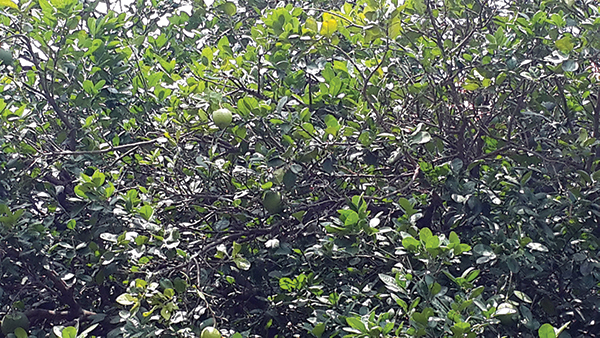Madhukarkati (Citrus decumana)
This plant is known as chakotara in Hindi and shaddock/ pomelo in English. It belongs to family rutaceae and amradiphal varg of bhavprakash nighantu. It is a widely distributed and widely used indigenous plant found in Indian subcontinent and is believed to be a hybrid of citrus maxima and the orange. The species is native to southern China and Malaysia and possibly other parts of southeast Asia, and is now cultivated in many tropical and semi-tropical countries for its large fruits.
Plant description: It is a medium-sized tree but the largest of all citrus species, with large leaves, flowers, and fruits. Pomelos are often confused with grapefruits, from which they can generally be distinguished by their larger size, thicker rinds, milder sweet flavor, and tough bitter membranes. The fruit tastes like a sweet, mild grapefruit. The tree has a rounded crown and grows 5 to 15 m tall. It has large evergreen oblong to elliptic leaves, 10.5 to 20 cm long, with winged petioles. The flowers and fruits are borne singly. Fruits are large, 30 cm or more in diameter, vary from round to pear shape, ripen to yellow, orange, or red and weighing up to 9 kg.
Ayurvedic pharmacology: rasa- madhur, amla, tikta guna- laghu veerya- sheeta vipaak- madhur
Chemical composition: It has alkaloids: 5-hydroxyacronycine, pumiline, prenyl citpressine, citropone A & B, glycocitrine in the roots and the bark of the plant, caffeine in the flowers. Carbohydrates- phytol, synephrine, methyl antralinate, fructose, glucose and pectin. Flavonoids: acacetin, rutin, tangeretin, cosmosiin, hespeidin, naringin, citric acid and ascorbic acid are present in the fruits.
Therapeutically useful parts: Leaves, root, bark and fruits.
Therapeutic uses: Juice of leaves is used in epilepsy, chorea and whooping cough. Oil from fresh leaves possess antibacterial and fungicidal activity. Fruits are used in asthma, cough, hiccough and epilepsy. Rind has anti-asthmatic and sedative effect and is useful in vomiting, colic and diarrhea. Root and bark has antimicrobial activity.
Dr. Pratibha Mamgain, Dept. of Ayurvedic Medicine

